|
|
|
Sort Order |
|
|
|
Items / Page
|
|
|
|
|
|
|
| Srl | Item |
| 1 |
ID:
192950
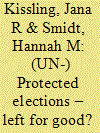

|
|
|
|
|
| Summary/Abstract |
How does the phased withdrawal of United Nations peacekeeping operations (PKOs) influence electoral violence? Many PKOs recently ended and peacekeeping personnel numbers are decreasing. Yet, research on peacekeepers’ exit remains in its infancy. We help fill this lacuna and examine how peacekeepers’ withdrawal affects violence during electoral periods. We focus on electoral periods because elections are both often-desired intervention endpoints and violence-prone moments in post-war trajectories. We argue that electoral violence increases shortly after a reduction in PKO troops because shortfalls in external oversight and security assistance reduce costs for organizing violence and open opportunities for pursuing a coercive electoral strategy. However, violence-inducing exit effects are likely short-lived due to adaptation by domestic security forces or peacekeepers who remain in the host country. We examine our argument across electoral periods and first-order administrative units of all African countries hosting a PKO (2001–2017). Controlling for violence trends prior to peacekeepers’ exit, two-way fixed effects models suggest that a local reduction in PKO troops is not associated with subsequent increases in electoral violence. However, withdrawal incidents lead to spikes in political violence more broadly defined. Our results confirm worries that downsizing during election times may endanger security gains in post-war countries.
|
|
|
|
|
|
|
|
|
|
|
|
|
|
|
|
| 2 |
ID:
196037


|
|
|
|
|
| Summary/Abstract |
How do armed actors affect the outcome of elections? Recent scholarship on electoral violence shows that armed groups use violence against voters to coerce them to abstain or vote for the group’s allies. Yet this strategy is risky: coercion can alienate civilians and trigger state repression. I argue that armed actors have another option. A wide range of armed groups create governance institutions to forge ties of political authority with civilian communities, incorporating local populations into armed groups’ political projects and increasing the credibility of their messaging. The popular support, political mobilization, and social control enabled by governance offer a means to sway voters’ political behavior without resorting to election violence. I assess this argument in the context of the Peruvian civil war, in which Shining Path insurgents leveraged wealth redistribution and political propaganda to influence voting behavior. Archival evidence, time series analysis of micro-level violent event data, and a synthetic control study provide support for these claims. These results have implications for theories of electoral violence, governance by non-state actors, and political behavior in war-torn societies.
|
|
|
|
|
|
|
|
|
|
|
|
|
|
|
|
| 3 |
ID:
117015
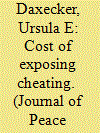

|
|
|
|
|
| Publication |
2012.
|
| Summary/Abstract |
This article investigates the relationship between international election observation, election fraud, and post-election violence. While international electoral missions could in principle mitigate the potential for violence by deterring election fraud, the ability of international observers to detect manipulation may in fact induce violent uprisings. Serious irregularities documented by international observers provide credible information on election quality, which draws attention to election outcomes and alleviates coordination problems faced by opposition parties and society. When elections are manipulated to deny citizens an opportunity for peaceful contestation and international observers publicize such manipulation, violent interactions between incumbents, opposition parties, and citizens can ensue. Consequently, the author expects that fraudulent elections monitored by international organizations will have an increased potential for subsequent violence. This expectation is evaluated empirically in an analysis of post-election conflict events for African elections in the 1997-2009 period. Using original data on electoral manipulation and reputable international election observation missions, findings show that the presence of election fraud and international observers increases the likelihood of post-election violence. Matching methods are employed to account for the possibility that international observers' decisions to monitor elections are endogenous to the occurrence of violence in the electoral process. Results for matched samples confirm the findings in the unmatched sample. A variety of robustness tests show that the results are not influenced by the operationalization of independent variables and influential observations.
|
|
|
|
|
|
|
|
|
|
|
|
|
|
|
|
| 4 |
ID:
172176
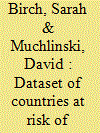

|
|
|
|
|
| Summary/Abstract |
Electoral violence is increasingly affecting elections around the world, yet researchers have been limited by a paucity of granular data on this phenomenon. This paper introduces and describes a new dataset of electoral violence—the Dataset of Countries at Risk of Electoral Violence (CREV)—that provides measures of 10 different types of electoral violence across 642 elections held around the globe between 1995 and 2013. The paper provides a detailed account of how and why the dataset was constructed, together with a replication of previous research on electoral violence. We introduce this dataset by demonstrating that the CREV, while measuring the same underlying phenomena as other datasets on electoral violence, provides researchers with the ability to draw more nuanced conclusions about the causes and consequences of violence that occurs in connection with the electoral process. We also present and analyze descriptive data from the CREV dataset.
|
|
|
|
|
|
|
|
|
|
|
|
|
|
|
|
| 5 |
ID:
165453
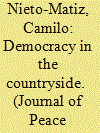

|
|
|
|
|
| Summary/Abstract |
What are the subnational variations of violence against voters? This article studies the effect of land concentration on electoral violence in the context of armed conflict in Colombia. My central argument is that electoral violence tends to be higher in municipalities where landowners are a relevant social actor. More concretely, in areas where violent groups dispute territorial control, higher levels of land inequality – a proxy for landowner prominence – have a positive effect on electoral violence. However, actors do not make the simple choice between violence or no violence but may also resort to fraudulent tactics. Because electoral fraud requires greater cooperation and coordination with the state, I argue that violent groups with stronger links to state officials and political elites are more likely to engage in fraudulent tactics compared to anti-government actors. To estimate the effect of land inequality on electoral coercion and fraud, I exploit the levels of soil quality as an instrumental variable for land concentration in Colombia between 2002 and 2011. This article contributes to the literature on the politics of land inequality; elections and electoral manipulation; and the use of violence in democratic settings.
|
|
|
|
|
|
|
|
|
|
|
|
|
|
|
|
| 6 |
ID:
120317
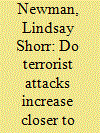

|
|
|
|
|
| Publication |
2013.
|
| Summary/Abstract |
The shadow of violence that elections cast remains poorly understood. A key obstacle impeding cross-national empirical analysis of electoral violence has been the varied nature of such violence. To address this challenge, I examine terrorist attacks as one particular form of electoral violence. By tracking the incidence of terrorist violence relative to election dates over time and across countries using an original dataset for the period from 2000-2005, I find strong support for the hypothesis that terrorist violence increases as we move closer to an election date. In fact, terrorist violence approximates a normal distribution centered on the election date.
|
|
|
|
|
|
|
|
|
|
|
|
|
|
|
|
| 7 |
ID:
148119
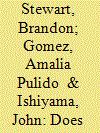

|
|
|
|
|
| Summary/Abstract |
What impact does violence have on ethnic identity? Do acts of violence tend to create greater segmentation and “hardening” of identities among ethnic groups? In this article, we empirically assess the claim that violence inevitably leads to the hardening of ethnic identity (which we operationalize as expressions of ethnic particularism over a national identity). Using survey data from Kenya covering the period 2005–2008, integrated with geocoded data on conflict events in Kenya during that period, and employing multilevel logistic regression analysis, we do not find support for the contention that ethnic identity hardens inevitably as the result of violence. Rather, our findings suggest support for a more nuanced view of the effects of violence on ethnic identity.
|
|
|
|
|
|
|
|
|
|
|
|
|
|
|
|
| 8 |
ID:
170806
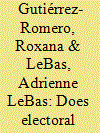

|
|
|
|
|
| Summary/Abstract |
Across many new democracies, voters routinely elect candidates associated with violence. Though electoral violence is common, there is little understanding of how it affects voting behaviour. This article examines how electoral violence affects turnout and vote choice. To this end, a vignette experiment is set in a nationally representative survey in Kenya, where electoral violence has been present since the 1990s. In the experiment, voters choose between two rival politicians. The experiment randomizes candidates’ attributes, their rumoured use of electoral violence and their record of reducing poverty. Conjoint analysis is used to isolate the effects of the candidates’ randomized attributes on turnout and vote choice. In contrast to the assumptions made in the literature on electoral violence, voters are less likely to vote for candidates rumoured to have used electoral violence, even when the candidate is a coethnic or a copartisan. This sanctioning effect, however, is not consistent across all voters. Victims of electoral violence and the poorest respondents are less likely to sanction candidates rumoured to have used violence, especially when these candidates have a good record of reducing poverty. The results show that voting turnout decreases when participants are asked to choose between candidates who are rumoured to have used electoral violence. These results are robust to including respondent and interviewer characteristics that might have affected participation in the experiment and how respondents voted. These findings explain why candidates using violence can win elections and why electoral violence has been difficult to eradicate in settings characterized by clientelism and instances of political discourse justifying the use of violence.
|
|
|
|
|
|
|
|
|
|
|
|
|
|
|
|
| 9 |
ID:
170809
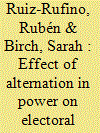

|
|
|
|
|
| Summary/Abstract |
There is as yet little consensus in the literature as to the underlying drivers of electoral violence. This article identifies a key mechanism explaining the use of electoral intimidation, a form of violence, in democratizing regimes. Within this context, we argue that the use of electoral intimidation against the opposition is most likely to be observed when a country moving to democracy has not yet experienced an electoral turnover. Building on previous theoretical and empirical findings, we provide evidence supporting the idea that alternation in power serves as an effective tool to decrease the tensions between electoral winners and losers. Furthermore, we show that alternation in power is conditional on the performance of electoral management bodies. Based on a sample of 331 elections in 53 countries that have inaugurated multiparty competition since 1989, we find strong and robust support for our theoretical claims. Firstly, we show how alternation in power is determined by the degree of autonomy the electoral management body adopted as part of the political opening process. Secondly, we provide evidence that electoral turnover depresses the use of electoral violence after controlling for relevant variables and correcting for selection issues.
|
|
|
|
|
|
|
|
|
|
|
|
|
|
|
|
| 10 |
ID:
142525
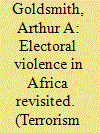

|
|
|
|
|
| Summary/Abstract |
This article addresses the still unsettled question of the incidence of violent election periods in Africa. It uses two new datasets, which report episodes of social conflict in the region for 1990–2011, and elections worldwide from 1960 to 2010. When combined, these data suggest that onsets of electoral violence peak around major election days in Africa as a whole, but with wide national variability in the volume of new episodes. Depending on the time span and type of social conflict, from one-quarter to three-quarters of the elections for national leadership have been without incident. The article also investigates the timing of electoral violence and the extent to which there is an experience curve effect, whereby subsequent elections have fewer onsets of social conflict. The data indicate that two-thirds to three-quarters of elections are free of onsets of social conflict, but that the proportion does not change much with experience. Overall, there appear to be reasonable grounds for optimism about peaceful elections in many African countries.
|
|
|
|
|
|
|
|
|
|
|
|
|
|
|
|
| 11 |
ID:
163190
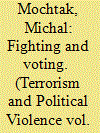

|
|
|
|
|
| Summary/Abstract |
lectoral disputes accompanied by violent outbreaks have become an emerging problem in societies under transformation, in authoritarian regimes, as well as in young democracies. The truth is that many politicians elected to office, their supporters, and political activists have altered their perceptions of electoral competition in a form of zero-sum logic with direct consequences for their opponents. After the fall of Communism in the beginning of the 1990s, Central and Eastern Europe stood at a crossroads. This period of imbalance and uncertainty affected the violent interaction in newly reformed electoral arenas with serious consequences for legitimizing democratic change. Despite the well-documented tension that existed in the region, the importance of violence in the electoral arena is rather neglected. The article approaches this gap as the first attempt to map electoral violence in a new typological environment where the process of transformation has affected political pluralism and the patterns of political contest. It argues that electoral violence is not a rare phenomenon in the region of post-Communist Europe and the dynamic varies on a great scale. Moreover, the article presents a picture of electoral violence occurring in different settings with potentially different contextual preconditions that need to be studied separately.
|
|
|
|
|
|
|
|
|
|
|
|
|
|
|
|
| 12 |
ID:
146922
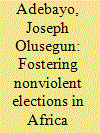

|
|
|
|
|
| Summary/Abstract |
Given that most Africans view political aspirants in terms of their ethnic and religious lineage rather than political ideology, and since most Africans rely on the media for information, there is a tendency to fall prey to biased and insensitive reportage, capable of inciting violence elicited by the prejudiced information often presented as news, features, commentaries, documentaries, etc. This article hypothesises that with appropriate training on conflict-sensitive reportage, journalists can foster peaceful and nonviolent elections through their reportage. The article recommends the adoption of an alternative method of news reportage using the peace-journalism model. The model, developed by Jake Lynch and Annabel McGoldrick, encourages journalists to report social issues in ways that create opportunities for a society to consider and value nonviolent responses toward conflict by using the insights from conflict analysis and transformation to update concepts of balance, fairness and accuracy in reporting. It also provides a new route map that traces the connections between journalists, their sources, the stories they cover and the consequences of their reportage. In addition, it builds awareness of nonviolence and brings creativity into the practical job of everyday editing and reporting. This article holds theoretical significance in that it explicitly identifies conditions that encourage journalists to apply conflict sensitivity to their reportage, thereby promoting societal peace, particularly during elections.
|
|
|
|
|
|
|
|
|
|
|
|
|
|
|
|
| 13 |
ID:
167290
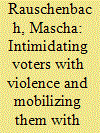

|
|
|
|
|
| Summary/Abstract |
Recent research suggests that intimidating voters and electoral clientelism are two strategies on the menu of manipulation, often used in conjunction. We do not know much, however, about who is targeted with which of these illicit electoral strategies. This article devises and tests a theoretical argument on the targeting of clientelism and intimidation across different voters. We argue that in contexts where violence can be used to influence elections, parties may choose to demobilize swing and opposition voters, which frees up resources to mobilize their likely supporters with clientelism. While past research on this subject has either been purely theoretical or confined to single country studies, we offer a first systematic cross-national and multilevel analysis of clientelism and voter intimidation in seven African countries. We analyze which voters most fear being intimidated with violence and which get targeted with clientelistic benefits, combining new regional-level election data with Afrobarometer survey data. In a multilevel analysis, we model the likelihood of voters being targeted with either strategy as a function of both past election results of the region they live in and their partisan status. We find that voters living in incumbent strongholds are most likely to report having being bribed in elections, whereas those living in opposition strongholds are most fearful of violent intimidation. We further provide suggestive evidence of a difference between incumbent supporters and other voters. We find support that incumbent supporters are more likely to report being targeted with clientelism, and mixed support for the idea that they are less fearful of intimidation. Our findings allow us to define potential hot spots of intimidation. They also provide an explanation for why parties in young democracies concentrate more positive inducements on their own supporters than the swing voter model of campaigning would lead us to expect.
|
|
|
|
|
|
|
|
|
|
|
|
|
|
|
|
| 14 |
ID:
183151
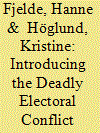

|
|
|
|
|
| Summary/Abstract |
This article introduces the Deadly Electoral Conflict dataset (DECO): a global, georeferenced event dataset on electoral violence with lethal outcomes from 1989 to 2017. DECO allows for empirical evaluation of theories relating to the timing, location, and dynamics of deadly electoral violence. By clearly distinguishing electoral violence from related (and sometimes concurrent) instances of organized violence, DECO is particularly suitable for investigating how election-related violence is connected to other forms of violent political contention. In the article, we present the theoretical and methodological underpinnings of the data collection and discuss empirical patterns that emerge in DECO. We also demonstrate one potential use of DECO by examining the association between United Nations peacekeeping forces and the prevalence of deadly electoral violence in conflict-affected countries.
|
|
|
|
|
|
|
|
|
|
|
|
|
|
|
|
| 15 |
ID:
092248
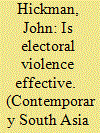

|
|
|
|
|
| Publication |
2009.
|
| Summary/Abstract |
This research note reports empirical findings from a study of the effectiveness of electoral violence and intimidation in Sri Lanka's 2005 presidential election. Using the previous 1999 presidential election as a baseline for comparison, analysis conducted at the polling division level reveals that both United National Party (UNP) candidate Ranil Wickramasinghe and United People's Freedom Alliance (UPFP) candidate Mahinda Rajapakse experienced declines in the percentage of votes in polling divisions where opponent party activists committed acts of violence or intimidation. Fewer polling divisions reported violence or intimidation by UNP than UPFP activists, but the former appear to have been more effective in demobilizing voters.
|
|
|
|
|
|
|
|
|
|
|
|
|
|
|
|
| 16 |
ID:
141230
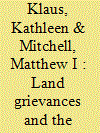

|
|
|
|
|
| Summary/Abstract |
Recent studies have asked why elites resort to violence, yet many overlook the process and dynamics of mobilizing violence. How do politicians convince their supporters to fight? This article argues that in multi-ethnic and democratizing societies where land and property rights are weak and politicized, land grievances can provide leaders with a powerful tool to organize electoral violence. We develop a theory to show how land grievances can give rise to violent mobilization when leaders frame elections as a threat to the land security of supporters or an opportunity to reclaim land or strengthen land rights. Conversely, land grievances are ineffective when citizens do not believe that elections signal a credible threat to their land security or an opportunity to strengthen land rights. We further specify how the type of land grievance shapes the logic and form of violent action. Grievances based on land insecurity shape a pre-emptive logic of violence, while grievances based on competing land claims often shape an opportunistic logic of electoral violence. The article examines the validity of our theory using a comparative case study between zones of escalation and non-escalation of violence during post-electoral crises in Kenya (2007–08) and Côte d’Ivoire (2010–11). By observing the variation between positive and negative cases, the article identifies factors that foment and constrain the mobilization of election violence.
|
|
|
|
|
|
|
|
|
|
|
|
|
|
|
|
| 17 |
ID:
184203
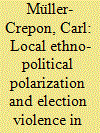

|
|
|
|
|
| Summary/Abstract |
How does local ethnic demography affect the conduct of majoritarian elections? Because legislative elections in majoritarian systems are contested locally, local ethno-political polarization increases the risk of pre-election violence. In districts that are polarized between politically competing ethnic groups, violence can be targeted with comparative ease at opposing voters, and can, if perpetrated collectively, mobilize the perpetrators’ co-ethnics. I do not expect such dynamics in PR systems where political competition plays out at higher geographical levels. To test this argument, I combine new data on the ethnic composition of local populations in 22 African countries with monthly data on riots and survey data on campaign violence. Ethno-politically polarized districts in majoritarian and mixed electoral systems see substantively larger increases in the number of riots prior to legislative elections and more fear of pre-election violence among citizens than non-polarized districts in the same country and at the same time. I do not find these patterns in PR systems. The results enhance our understanding of how electoral systems interact with local ethnic demography in shaping pre-election violence.
|
|
|
|
|
|
|
|
|
|
|
|
|
|
|
|
| 18 |
ID:
175827
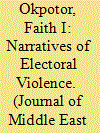

|
|
|
|
|
| Summary/Abstract |
This article addresses post-election violence (PEV) in Africa by drawing on the lived experiences of respondents in Côte d’Ivoire and Nigeria. It takes an actor-centered approach steeped in interpretivism and reflexivity in analyzing Côte d’Ivoire’s 2010–2011 and Nigeria’s 2011 PEV. It examines PEV from the viewpoint of a variety of actors, including political party leaders, party activists, electoral commission officials, non-governmental organization (NGO) officials, academics, scholars, and human rights experts. With attention to methodological and personal positionality, the study draws on interviews conducted in 2014 and 2015. It also analyzes the dominant discourses that contributed to a violent reaction to a contested election outcome, and thus highlights the socially-constructed conditions that allow for the possibility of violence. Salient issues arising from these narratives include: the role of decades-long unresolved violence episodes in fueling PEV, the role of political leaders in exploiting grievances associated with these past violence episodes, and the power of electoral violence prevention strategies targeted at principal actors in curbing the progression to violence.
|
|
|
|
|
|
|
|
|
|
|
|
|
|
|
|
| 19 |
ID:
169907
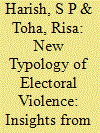

|
|
|
|
|
| Summary/Abstract |
Existing literature on election violence has focused on how violence suppresses voter participation or shapes their preferences. Yet, there are other targets of election violence beyond voters who have so far received little attention: candidates and government agencies. By intimidating rival candidates into dropping out of the race, political hopefuls can literally reduce the number of competitors and increase their likelihood of winning. Likewise, aspiring candidates can target government agencies perceived to be responsible for holding elections to push for electorally beneficial decisions. In this paper, we introduce a new typology of electoral violence and utilize new data of election violence that occur around executive elections in Indonesia from 2005 through 2012. The types of violence we identified differ in these ways: a) Of all cases of electoral violence observed in this article, most incidents were targeted towards candidates and government bodies; b) candidates are generally targeted before elections, whereas voter-targeting incidents are spread out evenly before and after elections and government-targeted violence tends to occur afterwards; c) pre-election violence is concentrated in formerly separatist areas, but post-election violence is more common in districts with prior ethnocommunal violence. These distinctions stress the importance of examining when and why different strategies are adopted.
|
|
|
|
|
|
|
|
|
|
|
|
|
|
|
|
| 20 |
ID:
170812
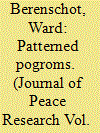

|
|
|
|
|
| Summary/Abstract |
The regular occurrence of election-related violence between ethnic or religious communities has generated a burgeoning literature on ‘the dark side’ of democracy. This literature provides convincing accounts of how political competition incentivizes politicians to foment violence. Yet such elite-oriented approaches are less convincing in explaining why and how political elites succeed in mobilizing people who do not share their concern for electoral benefits. This article addresses this challenge by relating the capacity of politicians to foment violence to the everyday functioning of patronage networks. Using ethnographic fieldwork to compare violent and nonviolent areas during Hindu–Muslim violence in Gujarat (2002) and Christian–Muslim violence in North Maluku (1999–2000), I find that the informal networks through which citizens gain access to state benefits (‘patronage networks’) shape patterns of election-related violence between religious communities. Politicians succeeded in fomenting violence in areas where citizens depended strongly on ethnicized patronage networks, while violence was averted in areas where state–citizen interaction was organized through networks that bridge religious divides. Interpreting this finding, I argue that patronage networks generate both infrastructure and incentives to organize violence. They provide the infrastructure for violence because their everyday functioning generates interdependencies between politicians and local followers that facilitate the instigation and organization of violence. Patronage networks also generate incentives for violence because when prevailing patronage networks bridge social divides, politicians relying on these networks have an interest in preventing communal violence. When socio-economic changes cause patronage networks to become organized along religious divides, as occurred in the violent areas in Gujarat and North Maluku, divisive political discourse is more likely to resonate and political actors are more likely to benefit electorally from communal violence. In this manner this article provides a novel explanation for both subnational variation in patterns of violence and the hardening of social divisions.
|
|
|
|
|
|
|
|
|
|
|
|
|
|
|
|
|
|
|
|
|